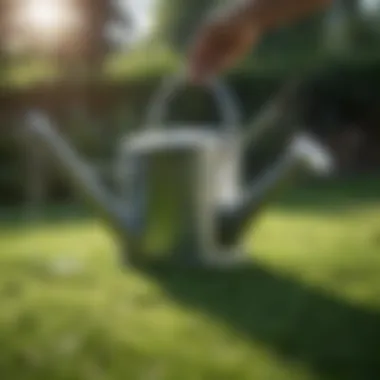Guidelines for Watering Grass After Fertilizing


Intro
Watering grass after fertilizing is a crucial step that significantly impacts the health and appearance of your lawn. Understanding the timing and technique of watering can enhance nutrient uptake, promote robust grass growth, and prevent common lawn issues. This article delves into various guidelines, focusing on the essential practices that every gardener should consider post-fertilization.
A key component of successful lawn care is not merely the application of fertilizer but also how the grass is watered afterward. Many individuals often overlook the importance of the watering process, leading to ineffective nutrient absorption or even damaging the grass. By examining the basic principles and common mistakes, homeowners can significantly boost their lawn's vitality.
Importance of Timing
Timing is everything when watering grass after applying fertilizer. Ideally, you should wait a few hours post-fertilization before starting to water. This allows the nutrients to settle into the soil, reducing the risk of the runoff that can wash away valuable fertilizers.
"Proper timing ensures that the grass absorbs the required nutrients efficiently, promoting a healthier lawn over time."
When to Water
- After Application: Wait for about 2 to 4 hours after applying fertilizer.
- Weather Considerations: If rain is expected, adjust your watering schedule accordingly. Overwatering can lead to nutrient runoff and poor grass health.
When Not to Water
- Immediately After Fertilizing: This can dilute the effectiveness of the fertilizer by washing it away before the grass has a chance to absorb it.
- During High Heat: Watering during the hottest part of the day can result in rapid evaporation, reducing water availability for grass.
Techniques for Effective Watering
Effective watering techniques can further enhance fertilizer results. Consider these techniques to maximize the benefits:
- Deep and Infrequent Watering: This approach encourages deeper root growth. Lawns typically require around 1 to 1.5 inches of water per week, including rainfall.
- Early Morning Watering: Watering early allows the grass to absorb moisture before the sun’s heat causes evaporation.
- Use of Sprinklers: Uniform distribution is crucial. Adjust your sprinklers to ensure even coverage across the lawn.
By employing proper techniques, homeowners can foster a thriving lawn that looks lush and inviting.
Common Mistakes
Even experienced gardeners can fall prey to common mistakes when watering after fertilizing. Recognizing these pitfalls can help avoid unnecessary challenges:
- Overwatering: Excessive watering can leach nutrients away from roots, thereby negating the effects of fertilization.
- Underwatering: Insufficient water can leave the fertilizer sitting atop the soil, preventing effective absorption.
- Ignoring Soil Type: Different soil types retain water differently, so understanding your soil can inform your watering schedule and amount.
Best Practices to Avoid Mistakes
- Monitor soil moisture regularly.
- Adjust your watering based on recent weather conditions.
- Employ a rain gauge to understand local precipitation and adapt accordingly.
Closure
Watering grass post-fertilization is not a one-size-fits-all activity. By paying attention to timing, employing effective techniques, and avoiding common errors, any gardener can boost their lawn's vitality. These guidelines can serve as a roadmap to achieving a green, healthy lawn that stands out in appearance and durability.
Preface to Lawn Care
Effective lawn care hinges significantly on understanding the relationship between fertilization and watering. This interaction is critical for achieving a lush and healthy lawn. Proper care doesn't start and end with simply adding fertilizer; it encompasses various practices, such as the timing and method of watering. The nuances of lawn care become evident when one appreciates that both too much water and too little can undermine efforts to nurture grass health.
The Importance of Grass Health
Grass health is a substantial indicator of the overall efficacy of lawn care practices. Healthy grass contributes to the aesthetics of a home and increases property value. Furthermore, robust lawn supports local ecosystems by fostering biodiversity. A well-maintained lawn can reduce soil erosion and helps in water retention, contributing positively to the environment. It is beneficial to routinely assess grass health through visual inspections. Look for uniform color and bounce back when stepped on, as these are signs of well-nourished grass.
Fertilization Basics
Understanding fertilization entails knowing what nutrients are necessary for grass to thrive. Key macronutrients include nitrogen, phosphorus, and potassium. Each plays a vital role. Nitrogen promotes growth and vibrant color, phosphorus supports root development, and potassium enhances overall plant health. Applying fertilizers at the appropriate times boosts nutrient availability to the grass.
Generally, these should be applied during the growing seasons: spring and fall for cool-season grasses, while late spring through summer is more suitable for warm-season varieties. Timing and method of both fertilization and subsequent watering must go hand in hand to ensure nutrients are effectively absorbed and utilized by the grass.
A balanced approach will typically yield the best results, allowing grass to flourish and adapt to environmental conditions.
Understanding Fertilizer Components
Understanding the components of fertilizers is critical in effective lawn care, specifically when considering how to water grass after fertilizing. Fertilizers provide essential nutrients that support healthy growth and resilience in grass. Knowing these component elements not only informs watering practices but also helps gardeners decide on the appropriate fertilizers for their specific lawn needs.


Nutrients in Fertilizers
Fertilizers contain three primary nutrients: nitrogen, phosphorus, and potassium, commonly referred to as N-P-K. Each nutrient plays a distinct role in plant health:
- Nitrogen promotes vigorous leaf and stem growth. It is crucial for the development of green, healthy foliage.
- Phosphorus supports root development and flower formation. This nutrient is essential for strong roots that can absorb water and nutrients effectively.
- Potassium enhances overall plant resilience and aids in water regulation. It is vital for helping grass withstand drought and disease.
In addition to these primary nutrients, other micronutrients like iron, manganese, and zinc also contribute to grass health. These components should be recognized, as they influence how and when you water after fertilizing. For example, excessive nitrogen can lead to rapid growth that may require more frequent watering to prevent burning.
Types of Fertilizers
There are two main types of fertilizers: synthetic and organic. Both have unique attributes and benefits that might affect how you approach watering.
- Synthetic fertilizers are chemically manufactured and often provide immediate nutrient availability. They usually require more careful watering practices. If applied too heavily, they can lead to nutrient runoff, especially if the grass is not watered adequately after application.
- Organic fertilizers, derived from natural sources, tend to release nutrients more slowly. They improve soil health over time and can enhance water retention capabilities. If you choose organic options, it might be beneficial to water afterward, but the urgency may not be as pronounced as with synthetic fertilizers.
The Role of Watering After Fertilizing
Watering grass after fertilization plays a critical role in promoting healthy lawn growth. Fertilizers contain essential nutrients that the grass needs to thrive. However, without proper watering, these nutrients may not reach the roots effectively, leading to suboptimal results. Understanding the importance of watering following fertilization helps homeowners cultivate a lush and vibrant lawn.
There are specific benefits to watering after applying fertilizer. Firstly, it activates the nutrients in the fertilizer, allowing them to dissolve and penetrate into the soil. Secondly, watering helps prevent the fertilizer from burning the grass blades. This can occur when granular fertilizer remains dry on the grass surface. Moreover, proper watering ensures even distribution of nutrients, facilitating consistent growth across the lawn.
Considerations regarding watering include the timing and amount. Immediate watering may be necessary after fertilizing, depending on the type of fertilizer used. The goal is to achieve a balance that promotes nutrient absorption without causing runoff. This requires attentiveness to weather conditions and soil moisture levels.
Proper watering is essential for maximizing the benefits of any fertilizer applied to your lawn.
Immediate Watering Needs
After applying fertilizer, immediate watering is crucial for several reasons. The first is to activate the fertilizer. Many fertilizers, especially granular types, need moisture to release their nutrients into the soil.
It is often recommended to water within 24 hours after fertilizing to minimize possible nutrient loss. If you wait too long, especially in hot conditions, you risk losing valuable components to evaporation or runoff. A good rule of thumb is to apply enough water to moisten the top 1-2 inches of soil. This depth allows the granules to dissolve and nutrients to move down toward the root zone.
Additionally, watering immediately can mitigate the risk of fertilizer burn. When fertilizer sits on the grass blades for too long, it can create a toxic environment that damages the grass. The immediate moisture will carry the fertilizer down into the soil, acting as a protective barrier against potential burns.
Long-Term Effects of Watering
The long-term effects of appropriate watering after fertilizing cannot be overstated. Repeatedly providing adequate moisture fosters healthier root systems. It encourages deep root growth, which in turn supports the grass during periods of drought. A well-watered lawn is more resilient and can better withstand environmental stresses.
Moreover, maintaining a consistent watering schedule helps balance nutrient uptake. When grass receives the right amount of water over time, it can utilize the nutrients more effectively. This leads to richer colors and improved texture, resulting in a lawn that is not only aesthetically pleasing but also robust against pests and diseases.
When to Water Grass Post-Fertilization
Knowing when to water grass after fertilization is crucial for ensuring the health and vitality of your lawn. Fertilization provides essential nutrients that promote growth, but the timing of watering can significantly impact how effectively the grass absorbs those nutrients. Watering too soon can wash away the fertilizer, while waiting too long might lead to nutrient lockout, ultimately stunting grass growth. Thus, understanding specific timing considerations and weather influences can help homeowners optimize the results of their fertilization efforts.
Timing Considerations
Several factors dictate the ideal timing for watering after applying fertilizer. Generally, you should aim to water within 24 to 48 hours post-fertilization. This window allows nutrients to seep into the soil, making them available for grass roots. However, timing can also vary based on the type of fertilizer used. For example, liquid fertilizers may require more immediate watering, compared to granular formulations which might benefit from a bit of time to settle.
Additionally, it’s important to align your watering schedule with the stage of grass growth. During spring and early summer, grass tends to be more active. Therefore, watering shortly after fertilizing during these periods is more beneficial than during dormancy in late fall or winter. Homeowners should also consider the type of grass they have. Cool-season grasses may need different approaches compared to warm-season varieties, thereby affecting when watering should take place.
Weather Influences
Weather conditions play a pivotal role in determining when to water grass after fertilizing. For instance, if rain is forecasted shortly after fertilization, homeowners might delay watering until it becomes clear if natural rainfall will suffice. On the other hand, during dry spells or extreme heat, immediate watering becomes necessary to prevent fertilizer burn and to protect the grass from stress.
Monitoring local conditions, such as humidity and temperature, is essential. Hot and dry conditions often necessitate more frequent watering; conversely, cooler, wetter periods may allow for extended watering intervals. Consider using tools like soil moisture meters to evaluate whether watering is truly needed. Incorporating such practices not only ensures effective nutrient absorption but also helps in conserving water.
Key Point: Timing of watering post-fertilization hinges on both fertilizer type and prevailing weather conditions. Adjusting accordingly can lead to a healthier lawn.
In summary, the key to successful watering lies in understanding the specific needs of your lawn and the context of your surroundings. By being aware of the timing considerations and weather influences, homeowners can maximize the benefits of fertilization, paving the way for a lush and thriving lawn.
Watering Techniques
Watering grass effectively after fertilizing is critical for ensuring that the nutrients from the fertilizer are absorbed properly. Different techniques can influence how water interacts with the soil and grass roots. Selecting the right method can greatly affect the overall health of the lawn. Homeowners should be aware of the specific elements that contribute to successful watering techniques.


Irrigation Methods
There are various irrigation methods that can be employed when watering grass. Each has its own set of advantages and potential drawbacks depending on the lawn's specific needs. Common methods include:
- Automatic Sprinklers: These systems can be programmed to water at specific times. They provide a consistent and uniform distribution of water, which helps in preventing dry spots.
- Drip Irrigation: Although more common for gardens, drip systems can be used for lawns, delivering water directly at the root zone. This method minimizes waste and promotes deep rooting.
- Soaker Hoses: These porous hoses allow water to seep out slowly along their length. They are beneficial for deep watering without saturating the surface too quickly.
- Hand Watering: Using a hose or a watering can allows precise control over where the water goes. This method is labor-intensive but can be effective for targeted areas.
Homeowners must consider the size of their lawn, the type of soil, and weather patterns when choosing an irrigation method. For instance, sandy soils may require more frequent watering, while clay soils hold moisture longer.
Using Sprinklers versus Manual Watering
When it comes to watering, there’s a choice between using sprinklers and manual watering. Each approach has arguments for and against.
- Sprinklers tend to save time and effort. They cover large areas quickly, making them ideal for bigger lawns. However, they can lead to overwatering if adjustments aren't made for rain or moisture.
- Manual watering offers greater control over water distribution. This method lets homeowners focus on particular areas needing attention while avoiding parts of the lawn that are already adequately hydrated. Nevertheless, it requires more time and physical effort, which may not be practical for everyone.
Ultimately, the choice between sprinklers and manual watering depends on personal preferences and the lawn's specific characteristics. An effective strategy often combines both methods to take advantage of their respective benefits.
"Understanding and choosing the right watering technique is fundamental to maintaining a vibrant and healthy lawn."
Consequently, mastering watering techniques not only enhances nutrient absorption from fertilizers but also contributes to the long-term success of lawn care efforts.
Common Mistakes After Fertilizing
Watering grass after fertilizing can be a critical step in maintaining an overall healthy lawn. However, many homeowners tend to make mistakes during this process, leading to unintended consequences. Understanding these common mistakes is essential for achieving optimal results with fertilization. The right watering approach not only supports the fertilization process but also contributes to the long-term health of your grass. A comprehensive awareness of over-watering and under-watering can provide significant benefits to your lawn.
Over-Watering Issues
Over-watering is one of the most prevalent mistakes many gardeners make after applying fertilizer. When excess water accumulates, it can wash away fertilizers before they have a chance to penetrate the soil. This can result in diminished efficacy of the applied nutrients.
Furthermore, over-watering can create waterlogged conditions, leading to compaction and root rot. This, then, creates an unhealthy environment for the grass roots to thrive. Additionally, it diminishes oxygen levels in the soil, further stressing the grass.
To avoid this issue, consider the following tips:
- Water deeply but infrequently, allowing time for the grass to absorb necessary nutrients.
- Ensure proper drainage, particularly in areas prone to pooling.
- Use a rain gauge to measure water application, helping maintain a steady schedule without overdoing it.
"Properly managing water levels post-fertilization can directly enhance grass health, preventing future problems that may arise from over-saturation."
Under-Watering Consequences
On the other hand, under-watering is also a common mistake that can leave your grass in distress. Insufficient water after fertilizing can prevent nutrients from dissolving effectively, making it hard for the grass to absorb what it needs for growth. Lack of moisture in the soil can lead to nutrient burn, where concentrated fertilizer harms the grass rather than benefits it. This often results in yellowing and patchy areas that exhibit signs of stress.
Here are some strategies to minimize under-watering:
- Monitor soil moisture regularly, using tools such as a soil moisture meter to gauge the need for watering.
- Water shortly after fertilization, ideally within 24 hours, to ensure fertilizers activate properly.
- Pay attention to weather conditions, as hot, windy days may increase evaporation rates, necessitating more frequent watering.
Signs of Improper Watering
Recognizing the signs of improper watering is vital for maintaining a healthy lawn after fertilization. Watering too much or too little can inhibit the grass’s ability to absorb nutrients effectively. By understanding these signs, homeowners can adjust their watering practices, ensuring that their lawns thrive rather than suffer.
Improper watering practices can lead to a range of issues, from brown patches to fungal diseases. Not addressing these signs can degrade the overall health of the lawn, causing significant long-term damage. Thus, vigilance in monitoring the lawn after watering is crucial.
Color Changes in Grass
Grass color serves as an essential indicator of its health. When grass appears yellow or brown, it usually signals distress. Various factors can cause these color changes. For instance, over-watering can lead to root rot, depriving grass roots of oxygen and nutrients. Conversely, under-watering can cause the grass to dry out.
Some symptoms of color changes include:
- Yellowing Grass: Often associated with nitrogen deficiency, over-watering can also cause yellowing due to poor oxygen flow.
- Brown Tips: Dry, crunchy grass edges indicate insufficient water, making the grass unable to absorb necessary moisture from the soil.
Monitoring these symptoms and adjusting the watering schedule accordingly can make a significant difference in grass health. Ideally, homeowners should aim for a deep green hue across their lawns, which indicates robust growth and healthy nutrient uptake.
Texture Alterations
The texture of grass provides another insight into its health. Grass should ideally possess a soft, lush feel. Texture alterations often denote underlying issues related to watering practices. For example, overly saturated soil can lead to mushy or spongy grass. Conversely, dry and brittle grass often results from insufficient watering.


Dull or coarse grass indicates that it is not receiving adequate care. Here are some texture signs to consider:
- Spongy Feel: Caused by over-watering, this signals that the grass roots may be struggling to access nutrients.
- Brittle Texture: Indicates an urgent need for water, as drought conditions stress the grass out.
The texture can be a critical aspect of lawn health. Regularly checking the texture of the grass can help in making immediate adjustments to watering schedules. Keeping the lawn well-hydrated while avoiding over-saturation is crucial for promoting healthy grass growth.
Environmental Factors Affecting Watering
Understanding the environmental factors that influence watering is crucial for maintaining a healthy lawn post-fertilization. Different elements such as soil type and sunlight exposure significantly impact how moisture is retained in your lawn. Recognizing these factors helps to optimize your watering strategies, ensuring that your grass receives the right amount of water without causing negative effects.
Soil Type Considerations
Soil type plays a vital role in determining how quickly and effectively water reaches the grass roots. The main types of soil include sand, silt, clay, and loam, each with unique characteristics:
- Sand: Drains quickly but retains little moisture. Lawns with sandy soil may require more frequent watering following fertilization.
- Silt: Holds water better than sand but not as well as clay. It typically has a balanced nutrient composition, making it relatively easier to manage.
- Clay: Retains moisture but can become compacted, leading to drainage issues. Underwatering may occur, so careful monitoring is necessary.
- Loam: Often considered the ideal soil type, loam drains well while retaining sufficient moisture and nutrients.
Familiarizing yourself with your soil type enables you to tailor your watering practices. For instance, if your lawn has sandy soil, you should implement a regular watering schedule to compensate for rapid drainage. Conversely, if you have clay soil, consider less frequent watering but with greater volume to achieve deep saturation.
Sunlight Exposure
Sunlight exposure is another key factor that affects watering requirements. The amount of sunlight your lawn receives each day will directly impact the soil's moisture levels and grass health. Areas in full sun will dry out faster compared to shaded regions, necessitating different watering strategies:
- Full Sun: Grass exposed to six or more hours of direct sunlight typically requires more water, especially after fertilization.
- Partial Shade: Grass in these areas may need less frequent watering as they retain moisture longer. Monitoring the grass's appearance is essential to determine undwrwatering or overwatering.
- Full Shade: Areas with little to no sunlight usually need minimal watering as the grass can withstand lower moisture levels.
To summarize, understanding soil type and the sunlight exposure of your lawn is essential to properly water grass after fertilizing. By accounting for these environmental factors, homeowners can ensure that their lawns receive adequate hydration, promoting healthier grass growth.
A successful lawn care routine embraces environmental conditions, optimizing growth while minimizing waste.
Best Practices for Effective Watering
Watering grass after fertilization plays an essential role in promoting lawn health. Understanding effective practices for watering can make a big difference. Proper watering encourages nutrient absorption and prevents common issues like brown patches or excess runoff. By following best practices, homeowners can maintain a vibrant and lush lawn.
Watering Schedule Maintenance
Establishing a consistent watering schedule is crucial. Grass needs a certain amount of water at regular intervals to thrive. Generally, watering early in the morning is preferred. This time minimizes evaporation and allows the grass to absorb moisture efficiently. Homeowners should aim to water about one to 1.5 inches per week, depending on climate and grass type.
Key points for water schedule include:
- Frequency: Adjust based on rainfall and temperature.
- Duration: Water deeply but infrequently. This promotes root growth.
Utilizing a simple irrigation timer can also enhance effectiveness. It helps to ensure that watering occurs at the ideal times. For those using hose sprinklers, observe the amount of water the lawn receives and adjust the timing accordingly.
Monitoring Soil Moisture Levels
Monitoring the moisture levels in the soil is an often neglected aspect of lawn care. Homeowners should check the soil's dampness before each watering session. An easy method is to dig a small hole about six inches deep to assess the soil moisture directly. Alternatively, use a moisture meter for precision.
Consider these factors to determine soil moisture:
- Topsoil condition: Dry topsoil indicates it’s time to water.
- Depth of moisture: Ensure that moisture reaches deeper roots for effective growth.
Watering only when necessary is key to avoiding overwatering. Overwatered grass can develop shallow roots, promoting unhealthy growth patterns. A healthy lawn thrives on a balance of moisture, ensuring grass develops roots that can withstand periods of drought.
Remember, lawns are living systems. Healthy grass depends on proper hydration and nutrients to flourish.
By adhering to these best practices, homeowners can cultivate a healthy lawn that not only looks good but also withstands the rigors of environmental stresses.
Epilogue
Understanding the best practices for watering grass after fertilizing is crucial for achieving a lush and healthy lawn. As discussed throughout this article, timing and technique are pivotal. Properly scheduling watering can significantly enhance the absorption of nutrients, ensuring that the fertilizer reaches the grass roots effectively. Furthermore, avoiding common mistakes - such as over-watering or under-watering - minimizes the risk of damage to your lawn and maximizes the effectiveness of the fertilizer applied.
Recap of Key Points
- Watering immediately after fertilizing helps in dissolving fertilizers and making nutrients available.
- Different soil types and weather conditions greatly influence watering needs.
- Maintaining a consistent watering schedule contributes to optimal grass health.
- Monitoring soil moisture levels is necessary to avoid making errors that can harm your lawn.
Future Considerations for Lawn Care
Beyond maintaining proper watering practices, homeowners should consider the long-term impacts of environmental changes on lawn care. As climate variations affect rainfall patterns, it will be important to modify watering schedules accordingly. Additionally, exploring new technologies, such as soil moisture sensors, can aid in making more informed decisions about when and how much to water. Educating oneself on emerging best practices can further enhance overall lawn maintenance, leading to a robust outdoor space.















